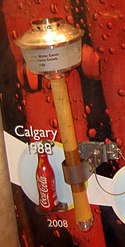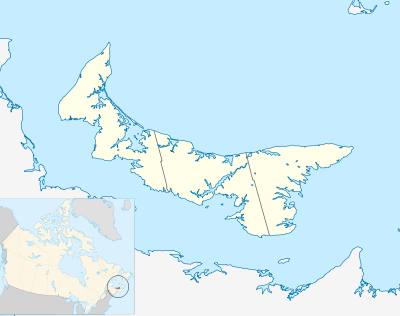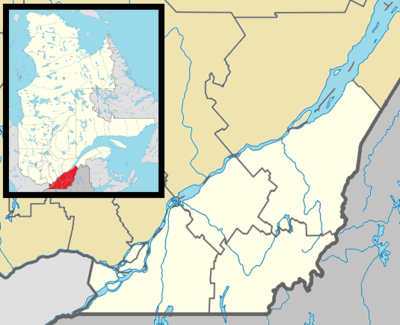1988 Winter Olympics torch relay
 | |
| Host city | Calgary, Canada |
|---|---|
| Countries visited | Greece, Canada |
| Distance | 18,000 km |
| Torchbearers | 6,214 |
| Start date | 15 November 1987 |
| End date | 13 February 1988 |
| Part of a series on |
| 1988 Winter Olympics |
|---|
|
The 1988 Winter Olympics torch relay was run from November 15, 1987, to February 13, 1988, prior to the Calgary 1988 Winter Olympics.
Organization
[edit]The planning of the Torch Relay required significant research and testing, with each kilometer of the relay test-driven three times, and estimates that each torch bearer would travel at a speed of 7 km/h.[1] The relay kept to secondary highways as much as possible and used snowmobiles for 2,750 km between Shanty Bay, Ontario and Prince Albert, Saskatchewan.[1] Overall the torch travelled approximately 11,000 km on land and 7,000 km by air or sea.[1]
Relay sponsor Petro Canada issued entry forms allowing citizens the chance to become one of 6,214 people to carry the torch for 1 kilometre (0.62 mi), torch bears were either chosen on merit or selected through random draws.[2][3] Organizers, who initially expected to receive 250,000 entries, were inundated with over 6.6 million forms and called the response a sign that the Olympics had "fired the imagination of Canada".[4][5] Part of the success for the number of applications was the OCO in February 1987 sending approximately 10 million applications out to virtually every Canadian household.[2] The relay, called "Share the Flame", also saw the torch travel by boat, snowmobile and dogsled.[1]
The Olympic Torch relay involved a convoy of 80 people in 40 support vehicles travelling 125 kilometers per day.[2]
Relay
[edit]The Olympic torch relay began when the torch was lit at Olympia and Greek runner Stelios Bisbas began what was called "the longest torch run in history".[6] The flame arrived in St. John's, Newfoundland on the Atlantic Ocean two days later and over 88 days, traveled west across Canada.[4] It passed through each provincial capital and many major cities, north to the Arctic Ocean at Inuvik, Northwest Territories, then west to the Pacific Ocean at Victoria, British Columbia before returning east to Alberta, and finally Calgary.[1] The route was designed in a way that 90 per cent of Canadians lived within a 2-hour drive of the route.[1] The torch covered a distance of 18,000 kilometres (11,000 mi), the greatest distance for a torch relay in Olympic history until the 2000 Sydney Games, and a sharp contrast to the 1976 Montreal Games when the relay covered only 775 kilometres (482 mi).[7]

The identity of the final torchbearer who would light the Olympic cauldron was one of OCO'88's most closely guarded secrets.[8][9] The relay began at St. John's with Barbara Ann Scott, a 1948 gold medalist in figure skating and Ferd Hayward, the first Newfoundlander to represent Canada at an Olympic games in 1952, both representing Canada's past Olympians.[8] The relay and ended with Ken Read and Cathy Priestner carrying the torch into McMahon Stadium representing the nation's current Olympians. They then stopped to acknowledge the contribution of para-athlete Rick Hansen and his "Man in Motion" tour [10] before handing the torch to 12-year-old Robyn Perry, an aspiring figure skater who was selected to represent future Olympians, to light the cauldron.[9] The choice of Perry was an unusual departure from most Games as the cauldron has typically been lit by a famous individual or group from the host nation.[11]
Protest
[edit]The relay was subject to peaceful protests by members and supporters of the Lubicon Cree First Nation at several stops in Ontario and Alberta in protest of ongoing land claim disputes between the band and the Crown, as well as discontent over an exhibit at Calgary's Glenbow Museum called "The Spirit Sings" that featured numerous artifacts stolen from native land.[12]
Olympic Torch
[edit]
The design of the Olympic Torch for the Calgary games was influenced by the landmark building of the Calgary skyline, the Calgary Tower.[13] The National Research Council Canada developed the design for the Torch,[13] which was constructed of maple, aluminum, and hardened steel, entirely Canadian materials, the torch was designed to remain lit despite the sometimes adverse conditions of Canadian winters.[14] The Torch had to be light enough for relay runners to carry comfortably, and the final design came in at 60 centimeters in length and 1.7 kilograms in weight.[13][4][15] The maple handle portion included laser-incised pictograms of the 10 official Olympic Winter sports, and lettering was engraved on the steel cauldron portion.[13] The torch used a combination of gasoline, kerosene and alcohol to allow a continuous burn during the unpredictable Canadian winter.[13] Approximately 100 torches were manufactured for the Games.[13]
The Calgary Tower itself was retrofitted to install a cauldron at its peak and was lit for the duration of the Games, one of several "replica cauldrons" constructed at Olympic venues throughout Calgary and Canmore.[16]
Notable torch bearers
[edit]- Alwyn Morris - Montreal, Quebec - 1984 Olympic kayaking champion.[17]
- Linda Thom - Kingston, Ontario - 1984 Olympic gold medalist in shooting.[18]
- Ben Johnson - Toronto, Ontario - Day 37 - Canadian Olympic Sprinter.[19]
- Angella Taylor-Issajenko - Toronto, Ontario - Day 37 - Canadian sprinter and silver medalist at the 1984 Olympic Games.[19]
- Maurice Vachon - Montreal, Quebec - Canadian wrestler in the 1948 Summer Olympics and professional wrestler.[20]
- Marilyn Brain - Moose Jaw, Saskatchewan - Canadian rower silver medalist in 1984 Summer Olympics.[21]
- Lori Fung - Vancouver, British Columbia - Canadian gymnast won gold medal in 1984 Summer Olympics.[22]
Route
[edit]| Date | Locations visited[23] | Map |
|---|---|---|
| November 17 | Newfoundland and Labrador: Signal Hill |
|
| November 18 | Holyrood | |
| November 21 | Nova Scotia: Antigonish |
|
| November 22 | Port Dufferin | |
| November 23 | Cole Harbour | |
| November 25 | Prince Edward Island: Wood Islands |
|
| November 26 | New Brunswick: Cape Tormentine Port Elgin Nova Scotia: New Brunswick: |
|
| November 27 | Moncton Riverview Salisbury Petitcodiac Sussex Apohaqui Norton Hampton[24] | |
| November 28 | Hampton Quispamsis Saint John Grand Bay Oromocto[24] | |
| November 29 | Oromocto Fredericton Woodstock[24] | |
| November 30 | Woodstock Hartland Florenceville Bristol Bath Perth-Andover Grand Falls[24] | |
| December 1 | Grand Falls Edmundston Saint-Jacques[24] | |
| December 2 | Quebec: Cabano |
|
| December 3 | Kamouraska | |
| December 4 | Quebec City | |
| December 5 | Donnacona | |
| December 6 | Shawinigan | |
| December 7 | Sorel-Tracy | |
| December 8 | Victoriaville | |
| December 9 | Bromptonville | |
| December 10 | St. Pie | |
| December 11 | Iberville | |
| December 12 | Montreal | |
| December 13 | Montreal | |
| December 14 | Laval | |
| December 15 | Lachute | |
| December 16 | Hull | |
| December 17 | Ontario: Cornwall |
|
| December 18 | Brockville | |
| December 19 | Millhaven | |
| December 20 | Colborne | |
| December 21 | Omemee | |
| December 22 | Pickering | |
| December 23 | Toronto | |
| December 24 | Clarkson | |
| December 25 | Brantford | |
| December 26 | Stoney Creek | |
| December 27 | Fort Erie | |
| December 28 | Dunnville | |
| December 29 | Aylmer | |
| December 30 | Rodney | |
| December 31 | Leamington | |
| January 1 | Tecumseh | |
| January 2 | Chatham | |
| January 3 | Reece's Corners | |
| January 4 | London | |
| January 5 | Kitchener | |
| January 6 | Orangeville | |
| January 7 | Shanty Bay | |
| January 8 | Callander | |
| January 9 | McKerrow | |
| January 12 | Nipigon | |
| January 13 | Shabaqua Corners | |
| January 14 | Dryden | |
| January 15 | Winnipeg Elie Portage la Prairie MacGregor Carberry outskirts of Brandon[25] |
|
| January 16 | Brandon Oak Lake Virden Elkhorn[25] Saskatchewan: | |
| January 17 | Indian Head Regina Moose Jaw Davidson[26][27] |
|
| January 18 | Davidson Bladworth Kenaston Hanley Dundurn Saskatoon Warman Hague Rosthern Duck Lake Prince Albert[27] | |
| January 19 | Northwest Territories: Yellowknife Yukon: |
|
| January 20 | British Columbia: Prince George |
|
| January 21 | Courtenay | |
| January 22 | Nanaimo | |
| January 23 | Victoria | |
| January 24 | Vancouver | |
| January 25 | Clearbrook | |
| January 26 | Spuzzum | |
| January 27 | Ashcroft Manor Ranch | |
| January 28 | Monte Creek | |
| January 29 | Kelowna | |
| January 30 | Oliver | |
| January 31 | Greenwood | |
| February 1 | Warfield | |
| February 2 | Creston | |
| February 3 | Cranbrook | |
| February 4 | Sparwood | |
| February 5 | Alberta: Brocket |
|
| February 6 | Lethbridge | |
| February 7 | Bow Island | |
| February 8 | Lloydminster | |
| February 9 | Grande Prairie | |
| February 10 | Namao | |
| February 11 | Wetaskiwin | |
| February 12 | Red Deer | |
| February 13 | Airdrie Calgary |
References
[edit]- ^ a b c d e f OCO'88 1988, p. 243
- ^ a b c OCO'88 1988, p. 241
- ^ OCO'88 1988, p. 245
- ^ a b c Findling & Pelle 1996, p. 313
- ^ Ferguson, Derek (1987-04-15). "6.6 million applications made to tote Calgary Olympic torch". Toronto Star. p. A1. Archived from the original on April 11, 2013. Retrieved 2013-03-10.(subscription required)
- ^ "Olympic torch begins journey to 1988 Winter Games", The Item (Sumter, SC), p. 4B, 1987-11-16, retrieved 2013-03-10
- ^ Factsheet: The Olympic torch relay (PDF), International Olympic Committee, 2012, pp. 4–7, retrieved 2013-03-10
- ^ a b OCO'88 1988, p. 247
- ^ a b Busby, Ian (2013-02-13), "Secret Service", Calgary Sun, p. S3
- ^ "Canadian Olympians". CP PHOTO and COA. 1988. Retrieved November 27, 2018.
"Canada's Cathy Preistner (left) and Ken Read (centre) receive the Olympic flame from Rick Hanson during the opening ceremonies of the 1988 Winter Olympics in Calgary
- ^ They lit the flame: torch carriers of the last 20 years, Associated Press, 2004-08-12, archived from the original on 2014-06-11, retrieved 2013-10-13 – via Highbeam
- ^ Findling & Pelle 1996, p. 315
- ^ a b c d e f OCO'88 1988, p. 249
- ^ Bradley, Jeff (1987-11-18). "Torch run starts Calgary Olympics". Spokane Spokesman-Review. p. D1. Retrieved 2013-03-26.
- ^ Norris, Alexander (1986-11-29). "Ottawa research team basks in glow of Olympic torch". Ottawa Citizen. p. A10. Retrieved 2013-03-26.
- ^ Joynt, Jerry (2013-02-09), "Tower flame kept secret until end", Calgary Herald, p. A17
- ^ Mennie, James (December 12, 1987). "Indian protest mars Olympic torch relay". The Montreal Gazette. ProQuest 431571191.
- ^ Crowley, Kevin; DeFries, Kathryn (December 19, 1987). "Torchbearers' notebook: an emotional journey for relay squad". The Whig - Standard. p. 3. ProQuest 353390054.
- ^ a b Moloney, Paul; Bilodeau, Paul (December 22, 1987). "Big Ben will carry torch to official Metro ceremony". Toronto Star. p. A4. ProQuest 435687546.
- ^ "Olympic torch gets a warm welcome". Montreal Gazette. December 14, 1987. p. A3. ProQuest 431572491.
- ^ "Protesters stay back as torch welcomed". Ottawa Citizen. Regina. The Canadian Press. January 18, 1988.
- ^ Flather, Patti (January 25, 1988). "Excited spectators cheer on Olympic relay: Thousands lined streets to watch torch run". Vancouver Sun. p. B1. ProQuest 243679741.
- ^ "Torch relay Olympians", Calgary Herald, November 17, 1987, page F11.
- ^ a b c d e f "Olympic Torch Arrives In N.B. Tonight", Saint John Times-Globe, November 25, 1987.
- ^ a b c "Chance to carry flame 'lucky opportunity'", Brandon Sun, January 13, 1988, page 2.
- ^ a b Petrie, Ron. "Many events planned for Sask. leg of torch relay", Regina Leader-Post, January 8, 1988, page D 10.
- ^ a b Traynor, Dave. "Sask. ready for Jan. 16 arrival of Olympic Torch", Saskatoon Star-Phoenix, January 7, 1988.
Further reading
[edit]- Hobson, Alan (1988). Share the flame: the official retrospective book of the Olympic torch relay. Vancouver: Murray/Love Productions. ISBN 0-921061-15-3.
- Findling, John E.; Pelle, Kimberly D., eds. (1996). Historical dictionary of the modern Olympic movement. Westport, Conn.: Greenwood Press. ISBN 0-313-28477-6.
- OCO'88 (1988), XV Olympic Winter Games: Official Report (in English and French), XV Olympic Winter Games Organizing Committee, ISBN 0-921060-26-2




















